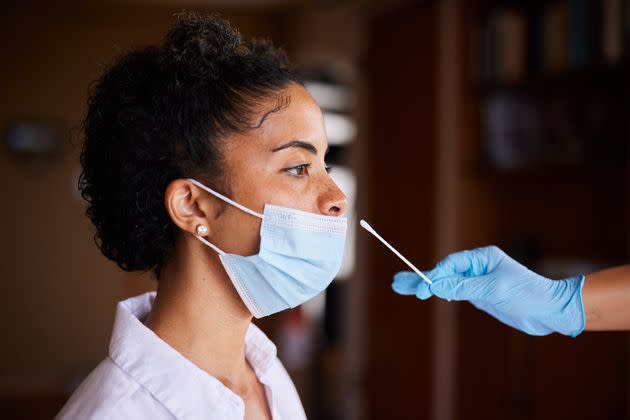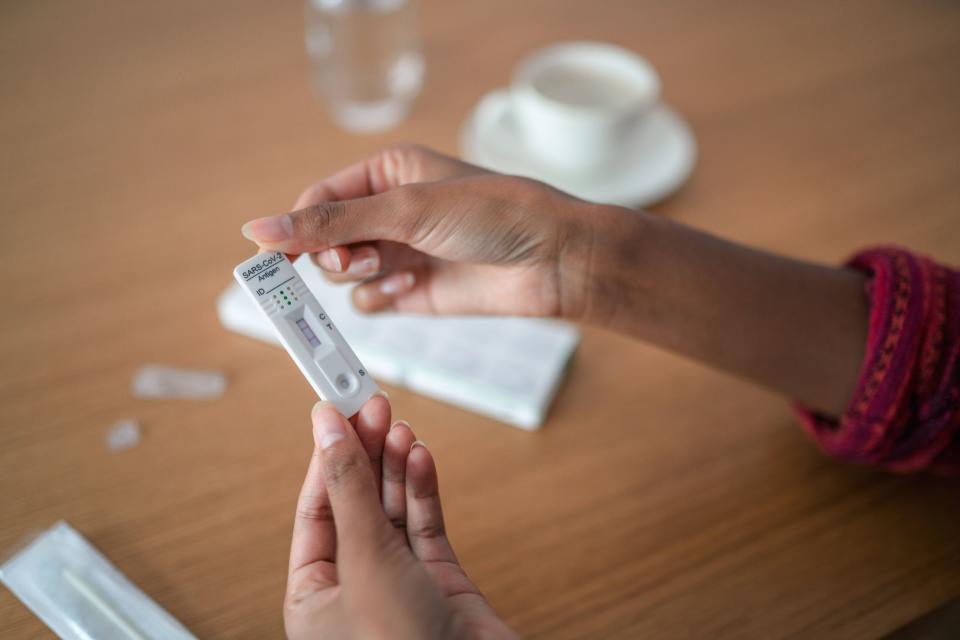What COVID Tests Can (And Can't) Tell You About Being Contagious

The Centers for Disease Control and Prevention has changed its guidance for people who are isolating with COVID a lot over the past month, and those changes have left a lot of people ... confused.
However, the bottom line for those who test positive for COVID — whether or not you’re vaccinated, and whether or not you have symptoms — is that you need to isolate for five days. At that point, if you’re symptom-free or your symptoms are improving, you can leave the house while wearing a mask around others. (If you’re not feeling better, you should stay isolated and talk to your doctor about next steps.)
What’s notably absent from those new guidelines — an omission that has been a source of lot of public debate in recent weeks — is a testing requirement. You do not need a negative test in order to leave isolation, which has a lot to do with the fact that many Americans simply can’t access timely testing right now. But it also reflects the somewhat puzzling fact that many people keep continue testing positive for COVID weeks, if not months, after they’re no longer contagious.
Why does that happen? And how should you handle testing after you’ve had COVID and ended your isolation or quarantine? Here’s what to know right now.
Most people are contagious just before symptom onset and two to three days after.
The CDC’s new shortened guidance reflects the agency’s belief that most COVID transmission occurs in the two days before a person’s symptoms start (or that person tests positive), as well as in the two to three days after. Research has also suggested that people who are asymptomatic are likely less contagious to others.
Initially, however, the CDC recommended a longer, more conservative 10-day quarantine guideline, rooted in data showing most people with mild to moderate COVID are no longer contagious after 10 days. Most people with severe to critical illness are no longer contagious after 20 days.
So are there people who could still be somewhat contagious on, say, day six? Probably yes. But the new shortened quarantined guidelines are rooted in the tricky compromise the CDC must make between science and practicality.
“There are two groups of people out there. I’m in the group that I thought the CDC got it pretty right, balancing exquisite public health with allowing society to function ... [but] there have been colleagues of mine, who are very astute, very insightful, who would like to introduce a testing option,” said William Schaffner, an infectious disease specialist with Vanderbilt University Medical Center.
PCR tests can continue to come back positive for weeks — or months.
Throughout the pandemic, experts have known that people who have recovered from COVID can have detectable bits of the virus in their upper respiratory tract for up to three months. PCR tests — long considered the gold standard — are sensitive enough that they can continue to pick up those bits (more scientifically known as RNA) well beyond the point when you’re actually a risk to anyone else.
“PCR tests do not test for the virus, they test for just some of the RNA of the virus. That works wonderfully if you have symptoms. But as it turns out, even though we get better, there can be viral remnants that are left in our body, and that test is so sensitive it can continue to pick it up,” Schaffner said.
That’s why it’s not recommended that you re-test with a PCR for 90 days — unless you develop symptoms during that time and a health care professional decides it is necessary for you.
If you test positive on a rapid test after day five, you could still be contagious.
While you don’t need to take a rapid antigen test to end quarantine — and you might not be able to get your hands on one right now — if you do take one on day five, for example, and it comes back positive, you might still be contagious.
“You are potentially infectious; likely much less so than you were on day three,” Schaffner said. Rapid antigen tests are useful for detecting high viral loads, so a positive result likely means you’re still shedding the virus, which likely makes you more contagious.
But in recent interviews, CDC Director Rochelle Walensky has hedged a bit, saying it’s not yet clear whether rapid at-home tests “give a good indication of transmissibility at this stage of infection.” It’s also worth keeping in mind that there isn’t a clear, established threshold of how much virus must be in your body in order to spread it to others. That is why the CDC says “strict” mask use until day 10 is so important.
“We know that this is not a light switch. It’s not a chemical reaction where everybody is negative on day six. That doesn’t happen. There’s a tail to the curve,” Schaffner said.
If you have questions or need proof you’re no longer contagious, talk to your doctor.
The most important thing to know is that you should follow the CDC’s guidelines — and keep on top of any changes. Don’t leave quarantine before you’re eligible. If you can get your hands on a rapid test, great. But also, if you have any questions about your experience, absolutely reach out to your doctor.
There might be instances in which you need a negative PCR result in order to be cleared for activities, like returning to the office or traveling internationally. In those cases, your doctor should be able to help by providing proof that you had the virus and recovered, even if PCR tests still show that you’re positive.
Remember, even after you’ve had COVID — and even if you’re vaccinated and boosted — it’s critical to continue to following public health guidelines around masking, social distancing, etc. As with everything else during this pandemic, the situation is fluid and experts are still discovering the best public health measures as things change.
Experts are still learning about COVID-19. The information in this story is what was known or available as of publication, but guidance can change as scientists discover more about the virus. Please check the Centers for Disease Control and Prevention for the most updated recommendations.
This article originally appeared on HuffPost and has been updated.

 money
money 


